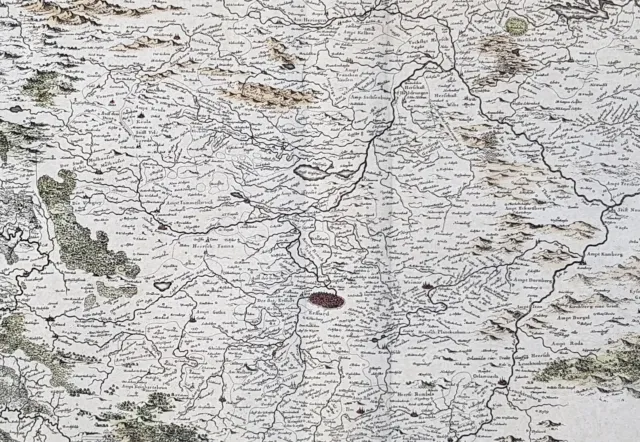1639 Henricus Hondius Original Antique Map of the German State of Thuringia
- contact us
- ebay profile
- ebay store
Thuringia Lantgraviatus Cartographer : - Hondius, Henricus 1587-1638 - Date: - 1639
- Size: - 22 1/2in x 19in (570mm x 485mm)
- Ref#: - 23434
- Condition: - (A) Very Good Condition
- Date: - 1639
- Size: - 22 1/2in x 19in (570mm x 485mm)
- Ref#: - 23434
- Condition: - (A) Very Good Condition
Description: This fine original antique map of the German State of Thuringia or Thüringen in central Germany was published by Henricus Hondius in the 1639 edition of Mercators Atlas. The map centers on the city of Erfurt and alos includes major cities of Gotha, Weimar, Schwartzburg, Halle, Jena, Mulhausen and others
General Definitions: Paper thickness and quality: - Heavy and stable Paper color : - off white Age of map color: - Original Colors used: - Yellow, green, blue, pink General color appearance: - Authentic Paper size: - 22 1/2in x 19in (570mm x 485mm) Plate size: - 20 1/2in x 16 1/2in (520mm x 420mm) Margins: - Min 1in (25mm)
Imperfections: Margins: - None Plate area: - Light creasing along centerfold, Verso: - Small repair to bottom left margin
Background: Named after the Thuringii tribe who occupied it around AD 300, Thuringia came under Frankish domination in the 6th century. Thuringia became a landgraviate in 1130 AD. After the extinction of the reigning Ludowingian line of counts and landgraves in 1247 and the War of the Thuringian Succession (1247–1264), the western half became independent under the name of \"Hesse\", never to become a part of Thuringia again. Most of the remaining Thuringia came under the rule of the Wettin dynasty of the nearby Margraviate of Meissen, the nucleus of the later Electorate and Kingdom of Saxony. With the division of the house of Wettin in 1485, Thuringia went to the senior Ernestine branch of the family, which subsequently subdivided the area into a number of smaller states, according to the Saxon tradition of dividing inheritance amongst male heirs. These were the \"Saxon duchies\", consisting, among others, of the states of Saxe-Weimar, Saxe-Eisenach, Saxe-Jena, Saxe-Meiningen, Saxe-Altenburg, Saxe-Coburg, and Saxe-Gotha; Thuringia became merely a geographical concept. Thuringia generally accepted the Protestant Reformation, and Roman Catholicism was suppressed as early as 1520; priests who remained loyal to it were driven away and churches and monasteries were largely destroyed, especially during the German Peasants\' War of 1525. In Mühlhausen and elsewhere, the Anabaptists found many adherents. Thomas Müntzer, a leader of some non-peaceful groups of this sect, was active in this city. Within the borders of modern Thuringia the Roman Catholic faith only survived in the Eichsfeld district, which was ruled by the Archbishop of Mainz, and to a small degree in Erfurt and its immediate vicinity. Hondius, Henricus 1587-1638 Jodocus Hondius, one of the most notable engravers of his time. He is known for his work in association with many of the cartographers and publishers prominent at the end of the sixteenth and the beginning of the seventeenth century. A native of Flanders, he grew up in Ghent, apprenticed as an instrument and globe maker and map engraver. In 1584, to escape the religious troubles sweeping the Low Countries at that time, he fled to London where he spent some years before finally settling in Amsterdam about 1593. In the London period he came into contact with the leading scientists and geographers of the day and engraved maps in The Mariner\\\'s Mirrour, the English edition of Waghenaer\\\'s Sea Atlas, as well as others with Pieter van den Keere, his brother-in-law. No doubt his temporary exile in London stood him in good stead, earning him an international reputation, for it could have been no accident that Speed chose Hondius to engrave the plates for the maps in The Theatre of the Empire of Great Britaine in the years between 1605 and 1610. In 1604 Hondius bought the plates of Mercator\\\'s Atlas which, in spite of its excellence, had not competed successfully with the continuing demand for the Ortelius Theatrum Orbis Terrarum. To meet this competition Hondius added about 40 maps to Mercator\\\'s original number and from 1606 published enlarged editions in many languages, still under Mercator\\\'s name but with his own name as publisher. These atlases have become known as the Mercator/Hondius series. The following year the maps were reengraved in miniature form and issued as a pocket Atlas Minor. After the death of Jodocus Hondius the Elder in 1612, work on the two atlases, folio and miniature, was carried on by his widow and sons, Jodocus II and Henricus, and eventually in conjunction with Jan Jansson in Amsterdam. In all, from 1606 onwards, nearly 50 editions with increasing numbers of maps with texts in the main European languages were printed. Summaries of these issues are given under the entry for Gerard Mercator. Jodocus Hondius the Elder * 1588 Maps in The Mariner\\\'s Mirrour (Waghenaer/Ashley) * 1590 World Map in two hemispheres illustrating Drake\\\'s circumnavigation * c. 1591-92 Hiberniae novissima descrzptio: Boazio\\\'s map of Ireland: Engraved by Pieter van den Keere * 1595 Europe (wall map): with Pieter van den Keere * 1598 World and the Continents * 1599 Maps for Caert Thresoor (Langenesi Cornelis Claesz), with Pieter van den Keere * 1602-03 - 12 English County maps for William Smith (\\\'anonymous maps\\\') * 1605 Ptolemy\\\'s Geographia (Mercator) 1618-19 Re-issued * 1605-10 Maps for The Theatre of the Empire of Great Britaine (Speed) * 1606 World Atlas (Mercator/Hondius series) (see under \\\'Gerard Mercator\\\' for further detail) * 1607 Atlas Minor (Mercator/Hondius series) (see under \\\'Gerard Mercator\\\' for further detail) * 1608 World Map on Mercator\\\'s projection Jodocus Hondius II * 1612-21 (Mercator) Atlas Minor 5 editions published in co-operation with Jan Jansson the Elder (see under Gerard Mercator (Atlas Minor) for further detail) * 1613 Map of Scandinavia * 1616 View of London (Cl. J. Visscher) * 1616 Tabularum geographicarum (Petrus Bertius) Miniature world atlas (8vo): edition (with new maps) of the Caert Thresoor published in 1598-99 1618 Re-issued in Latin and French * 1617-18 World Map: double hemisphere The first map to show Tierra del Fuego as an island as a result of the discoveries made on the Schouten/Le Maire voyage of 1615-17. * c. 1624 World Map on Mercator\\\'s projection * 1629 Atlas (without title or text) 42 maps, mostly by Hondius, not included in the Mercator/Hondius editions Henricus Hondius * (1606) Mercator\\\'s Atlas (Mercator/Hondius/Jansson) 1613, 1619 Editions published by the widow of Jodocus Hondius the Elder, and Jodocus II and Henricus. 1623-335 editions published by Henricus alone. 1633-41 5 editions in conjunction with Jan Jansson. When Jodocus II died in 1629, he and his brother, Henricus Hondius, while collaborating on the Hondius Atlas Major, had established and maintained separate business for some 10 years. Jodocus\\\' death enabled the competing cartographer, Willem Blaeu to acquire a large number of Jodocus\\\' map plates, which he promptly published in 1630 as the Atlantis Appendix. Henricus, in the meantime, had been counting on Jodocus\\\' new plates to enhance his own, by then outdated, Hondius Atlas Major. A surviving contract dated March 2, 1630 reveals that Henricus Hondius and his partner Joannes Janssonius hired engravers to produce a number of new map plates copying the work of Jodocus – now in the hands of the Blaeu firm. This map was among the most important of that group and accounts for variants of this map being issued by competing Blaeu and Hondius firms. What is an Antique MapThe word Antique in the traditional sense refers to an item that is more than a hundred years old. In the past maps were sold in two forms, as a single sheet (broadsheet) or bound in an atlas or book. The majority of antique maps for sale today come from books or atlases and have survived due to the protection offered by the hardback covers.
When considering a purchaseThe first thing to determine when staring a collection or purchasing an item, is what is important to you. Most collectors prefer to build their collections around a theme. You may decide to collect maps from one region or country, charting its development through time. Similarly you could collect maps of one particular period in time, by type (i.e. sea or celestial charts) or by cartographer. The collector might also want to consider the theme of cartographical misconceptions such as California as an island or Australia as Terra Australis or the Great Southern Land. The subject is so wide that any would-be-collector has almost endless possibilities to find his own little niche within the field, and thereby build a rewarding collection.
Starting a collection & pricingPricing is based on a number of different factors, the most important of which is regional. In any series of maps the most valuable are usually the World Map and the America/North America. The World because it is usually the most decorative and America because it has the strongest regional market. Other factors that come into play re: price is rarity, age, size, historical importance, decorative value (colour) and overall condition and quality of paper it is printed on. As specialised dealers, we frequently work with first time map buyers who are just starting their collection. Guiding new collectors on their first antique map purchase and helping new collectors to focus their interests is one of the most rewarding aspects of being an rare map dealer. So please do not hesitate to contact us and we will be happy to help with any questions you may have.
Payment, Shipping & Return OptionsPlease click on the \"Shipping and Payments\" Tab above for shipping, payment and return details
About USClassical Images was founded 1998 and has built an excellent reputation for supplying high quality original antiquarian maps, historical atlases, antique books and prints. We carry an extensive inventory of antiquarian collectibles from the 15th to 19th century. Our collection typically includes rare books and decorative antique maps and prints by renowned cartographers, authors and engravers. Specific items not listed may be sourced on request. Classical Images adheres to the Codes of Ethics outlined by the Antiquarian Booksellers Association of America (ABAA). We are a primarily an online based enterprise, however our inventory may be viewed by appointment. Please call or email to arrange a viewing.
- Condition: Fine
- Date Range: 1600-1699
- Type: World Atlas
- Format: Atlas Map
- Printing Technique: Copper Plate
- State: Thuringia
- Original/Reproduction: Antique Original
- Cartographer/Publisher: Henricus Hondius
- City: Erfurd
- Country/Region: Germany
- County: Thuringia
PicClick Insights - 1639 Henricus Hondius Original Antique Map of the German State of Thuringia PicClick Exclusive
- Popularity - 1 watcher, 0.0 new watchers per day, 494 days for sale on eBay. Normal amount watching. 0 sold, 1 available.
- Best Price -
- Seller - 5,981+ items sold. 0% negative feedback. Top-Rated Plus! Top-Rated Seller, 30-day return policy, ships in 1 business day with tracking.
People Also Loved PicClick Exclusive
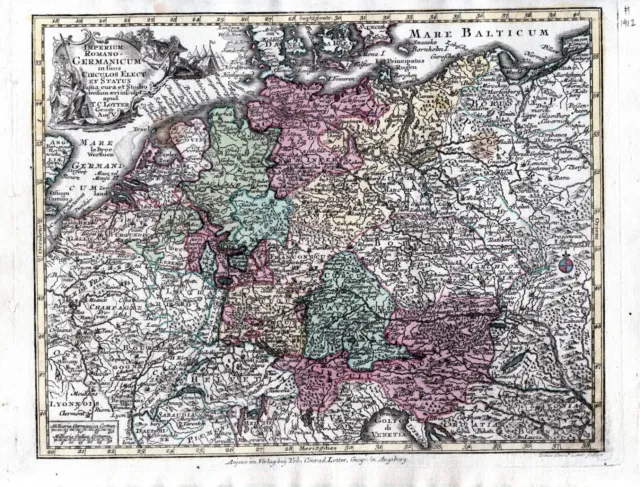
Antique map, Seutter / Lotter, c. 1744, Imperium Romano-Germanicum ...
$124.46 Buy It Now 29d 4h
Large Hand-Colored Holy Roman Empire Map of Provinces 1692 Rare
$275.00 Buy It Now 9d 1h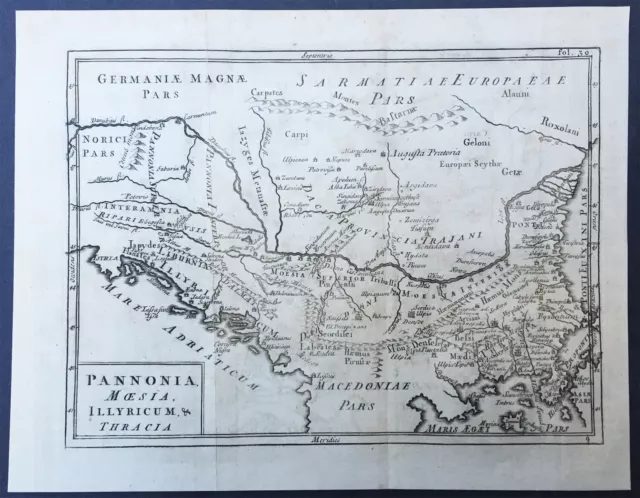
1720 Cellarius Antique Map of Europe - Balkans, Macedonia Hungary & Germany
$60.49 Buy It Now 20d 20h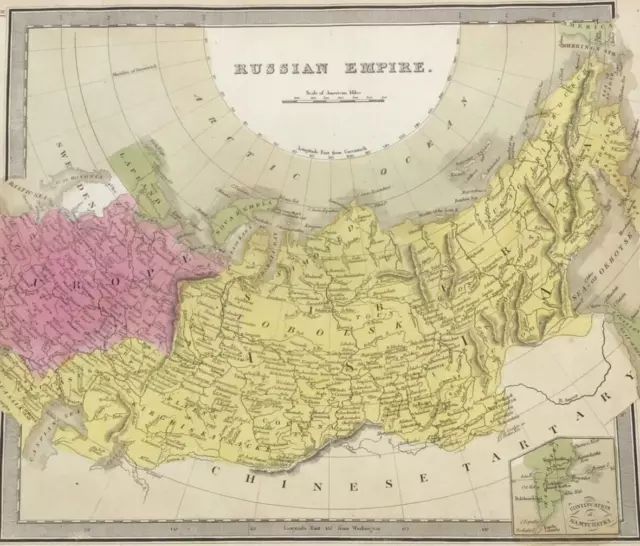
1842 Rare Map of "RUSSIAN EMPIRE" - Jeremiah Greenleaf - American Cartographer
$20.00 Buy It Now 3d 9h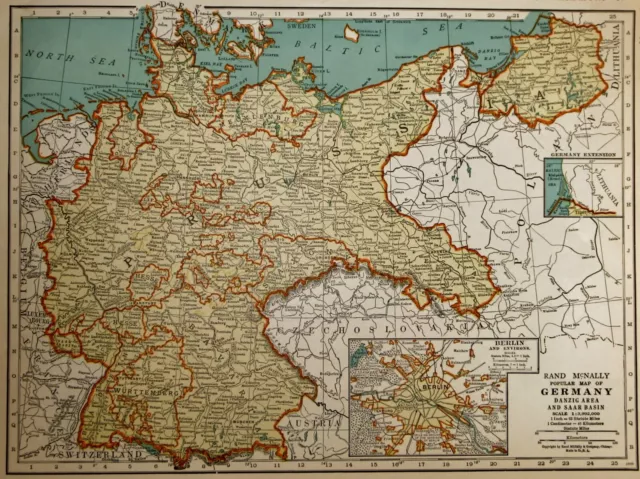
Vintage 1937 Atlas Map Pre WWII Germany, Spain, Portugal Europe World War II Era
$12.99 Buy It Now 6d 8h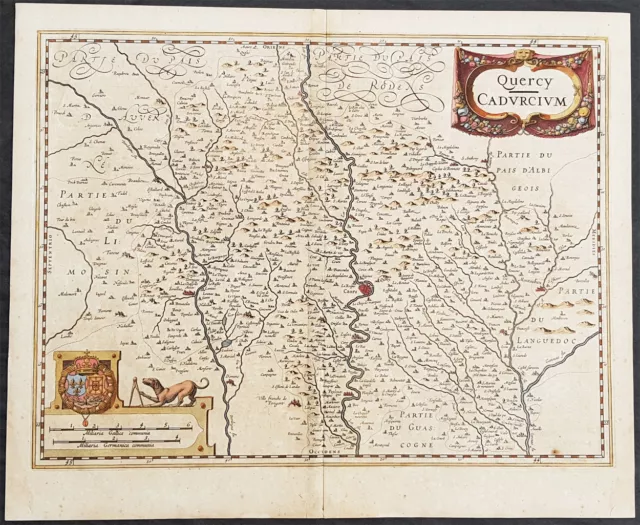
 1628 Henricus Hondius Antique Map The Province of Quercy, Lot, Cahors, SW France$264.79 Buy It Now
1628 Henricus Hondius Antique Map The Province of Quercy, Lot, Cahors, SW France$264.79 Buy It Now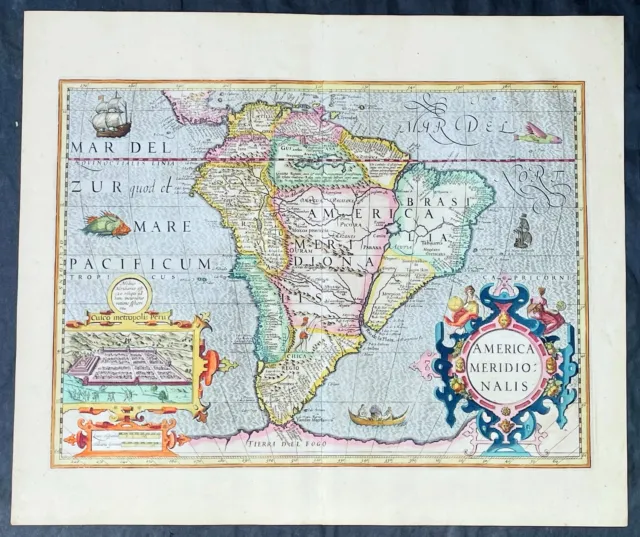 4 watchers
4 watchers 1628 Henricus Hondius Antique Map of South America, inset of Cusco - Beautiful$3,404.49 Buy It Now or Best Offer
1628 Henricus Hondius Antique Map of South America, inset of Cusco - Beautiful$3,404.49 Buy It Now or Best Offer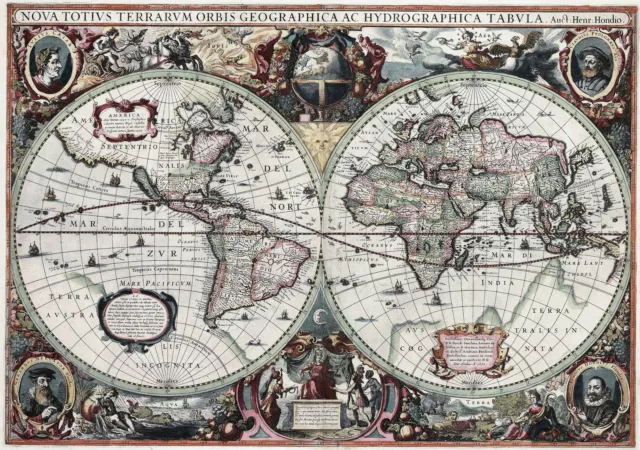 2 watchers
2 watchers 1630 Map of the World by Hendrik -Henricus- Hondius Historic Graphic Art Print$19.19 Buy It Now
1630 Map of the World by Hendrik -Henricus- Hondius Historic Graphic Art Print$19.19 Buy It Now 2 watchers
2 watchers 1639 Henricus Hondius Antique Map of France$603.73 Buy It Now or Best Offer
1639 Henricus Hondius Antique Map of France$603.73 Buy It Now or Best Offer

